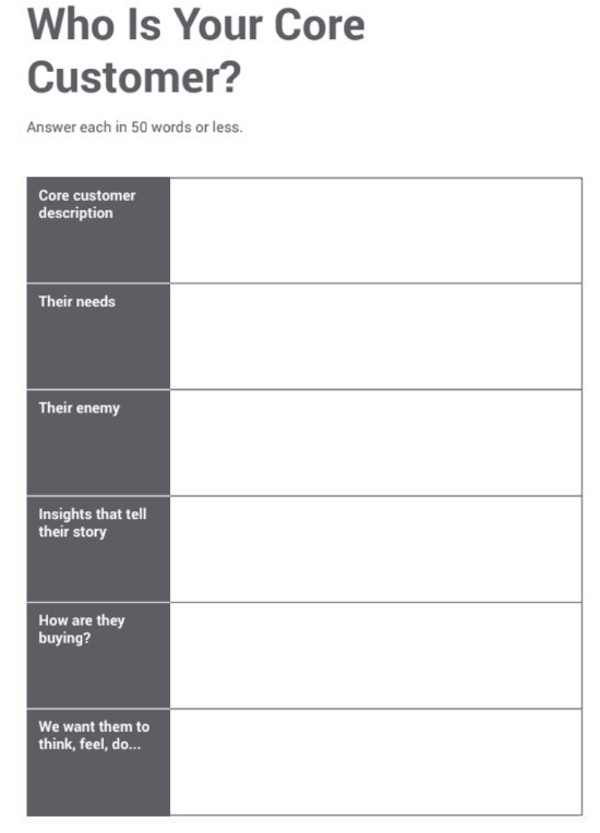If there’s one thing that most CEOs struggle with, it’s knowing who buys their company’s products. Early on in our coaching relationship, we ask our CEO clients to tell us about their core customer. Typically, they’ll give us two responses. The first is, ‘We don’t have one core customer, we have loads’. And the other? We’ll hear all about their average customer or their most numerous type of customer. Neither of these is their true core customer.
So instead, we ask the client to focus on a customer that represents the majority of their gross profit. Because this is the type of core customer that will drive future growth. It may not be immediately obvious. As Marshall Goldsmith said in his book of the same title, ‘What got you here won’t get you there’. It’s time to get deliberate about exactly where your future growth will come from. And it may not be what’s got you to this point.
Finding the right core customer could be the biggest single difference you make to your organisation. For some of our clients, it’s resulted in them doubling their business in 12 months. And forget what Simon Sinek says. I’ve always disagreed with his famous TED talk, ‘Start with Why?’ Instead, start with ‘Who?’ Who are you going to serve better than anyone else in the world? Who is going to buy from you at a maximum profit? It all sounds so simple. It’s actually deceptively hard. Based on our experience, here are our tips for getting total clarity on your core customer.
Getting started
Schedule some dedicated time in the diaries of your Executive Team and make sure there are no other distractions. Start by getting a rough overview of your current customer base. Work out what types of customers you have and how many strata. Define and rank them using the same measurement such as revenue, margin or volume. Then see if you can tease out the gross profit for that cohort. And ideally the growth rate or churn, year-on-year.
When we did this with one of our clients, they could see they were supplying the same product to three very different marketplaces. Previously they’d had a plan to grow their revenue in one of these markets. As a result, they’d sunk a disproportionate amount of marketing effort and spend into it. But as we crunched the data, it was clear this hadn’t resulted in winning many new customers. When they divided their base into cohorts, they realised their profitable customers were long-standing and in one specific market. Decisions were made to stop trying to sell into the other two. One market was closed down and the other re-purposed so they could focus all their effort on their core base. This was how they would grow faster.
Describing your core customer
Once you’ve zoned in on the cohort that will buy from you at the highest profit, narrow it down to a single person. Someone who best represents these core customers. And then get your Executive Team to work through a series of questions as below.

Firstly, give them a name. One of our clients has chosen ‘Andrew’ – he was the customer that most clearly embodied the profile for them. Write a description of Andrew. Aged between 45 and 55. Works for a Tier 1 TelCo. He’s a rights-holder or broadcaster and the key decision-maker in the business for everything digital. He’s got a budget of about £70K per year for a platform.
Working out their needs and enemies
Then get into Andrew’s needs. We covered this when exploring value propositions in last week’s blog. What does he need, more than anything, from your business? What are the problems he’s facing? In terms of fulfilling these needs, what can you be the best in the world at?
Sometimes this isn’t as obvious as it seems. For example, if you talked to an estate agent, they might say they’re in the business of helping people move house. But if you think back to your experience of moving, the estate agent only does a tiny fraction of the process. No estate agent has ever persuaded anyone to sell their house. When you’ve decided you want to move, you go and find the least-worst estate agent. In fact, they are in the business of helping you find a buyer for your house. It’s a subtle but important difference.
When we think about needs, we often refer to the work of Robert Bloom in his book, ‘The Inside Advantage’. He suggests that if you fulfil one need for a client, they’re likely to trust you to do other things. But there’s a catch. When we defined Andrew, we identified that he’s a buyer of digital platforms. He’s got nothing to do with heating, so he’s not going to buy this from you. That’s a different core customer altogether. You’re looking at the need of the buyer and not of the company. The number of times we see clients in the mindset of thinking they’re selling to a whole organisation. There’s an assumption that, once they’ve sold one product, they’ll be able to sell another. But a sale is human being to human being. If there’s no relationship there, you’re on a hiding to nothing.
You also need to work out your core customer’s enemies. Back to Andrew. We identified he didn’t have enough time for meetings so lacked understanding of the project. There were also competitors who were delivering high-value applications.
Insights, how they buy and how you want them to feel

The final questions enable you to drill down further into the nature of your core customer. What insights tell their story? Perhaps you’ve met them at a trade show. Or they have limited technical expertise. We worked through this with an SEO company that’d identified their core customer as the founder of a small business with no marketing manager. What was the insight here? As soon as customers recruited a marketing manager, their accounts became much more complicated and less profitable to serve well. So they were less attractive.
Work out how your core customer is likely to buy from you. Are they doing a Google search and finding you online? Or reading particular articles? Or going to events? When exploring this for Andrew, our client recognised that he appreciates a detailed statement of work because he thinks that this de-risks the project.
And the final question? It’s often the most difficult to answer. How do you want them to think, feel or do when they’ve signed a contract with you? Maybe it’s the satisfaction of knowing they’ve saved money. Or the kudos amongst their colleagues for being smart. Perhaps a strong sense of a win for them and for the company. How did you feel when you bought your last car? Do your customers have similar feelings when they buy from your company? Should they?
Having built a comprehensive profile of Andrew, you could even take a leaf out of Amazon’s book. They have a full size, cardboard cutout of their core customer that they take to all their meetings. Great idea for keeping them top of everyone’s mind!
Quality not quantity
People often make the mistake of looking for the largest addressable market as part of this process. But identifying your core customer is spearfishing not trawling. You’re saying, ‘What’s our revenue goal?’, What are our most profitable core customers?’ and ‘How many of these core customers do we need to achieve the goal?’ You’ll be surprised. It’s often a small number.
Looking back to when I took over as CMO of Peer 1, we had 13,400 customers. So I got my team to do some analysis. We split these customers into three groups based on the volume of support tickets. Each chunk generated the same volume as the next one. In the bottom third, we had about 12,000 of the total number of customers. And at the top? Just 500 representing 60% of our revenue. And generating the same support load. Furthermore, this small group of high-value customers had negative churn. They were growing by 4% month on month. And the bottom chunk was shrinking by 1% a month.
Laser-targeting
At Peer 1, we worked out that between the middle tier and the top tier, 50 customers graduated upwards in an average year. So if our target was to double the business in three years, we could work out how much of this growth would come from existing customers and how much from new ones. We could easily go from 500 to 1000 high value, core customers spending $10K a month or more. This would be enough to double the size of our business.
Once we had a target number for these new core customers, we could introduce this laser focus into Sales. Every day, week, month and quarter we tracked this. Any opportunity that was worth $10K or more was given priority, with a ‘refuse to lose’ mindset. And every one of them had an executive sponsor so we could improve our close rate. Marketing was clear that their job was to find more of these clients and our new business sales team focused all their effort on winning them.
By identifying a small number of highly profitable core customers, everything becomes manageable. Before, you might have been setting your sights on thousands of new customers. Now, you only need to win 100 globally each year. And you can drill into whatever you might need to win them. At Peer 1, we realised these core clients were running VMWare. So we got amazing at VMWare through strategic alliances. They also used e-commerce solutions such as Magento Enterprise. So we became world-famous for e-commerce. Our strategy and tactics were driven by a total understanding of the needs of our core customers.
Written by business coach and leadership coaching expert Dominic Monkhouse. Contact him to schedule a call here. You can order your free copy of his book, Mind Your F**king Business here.

